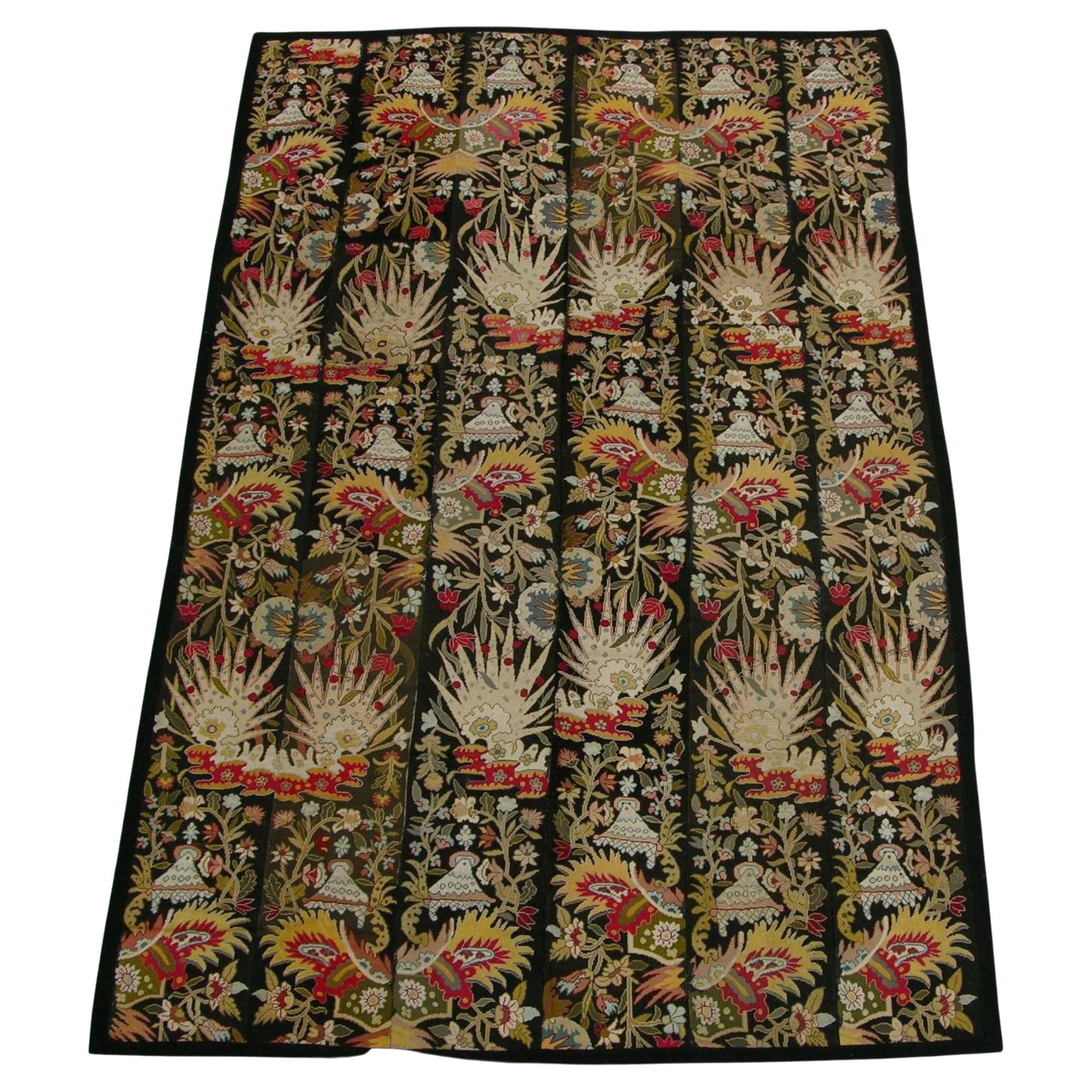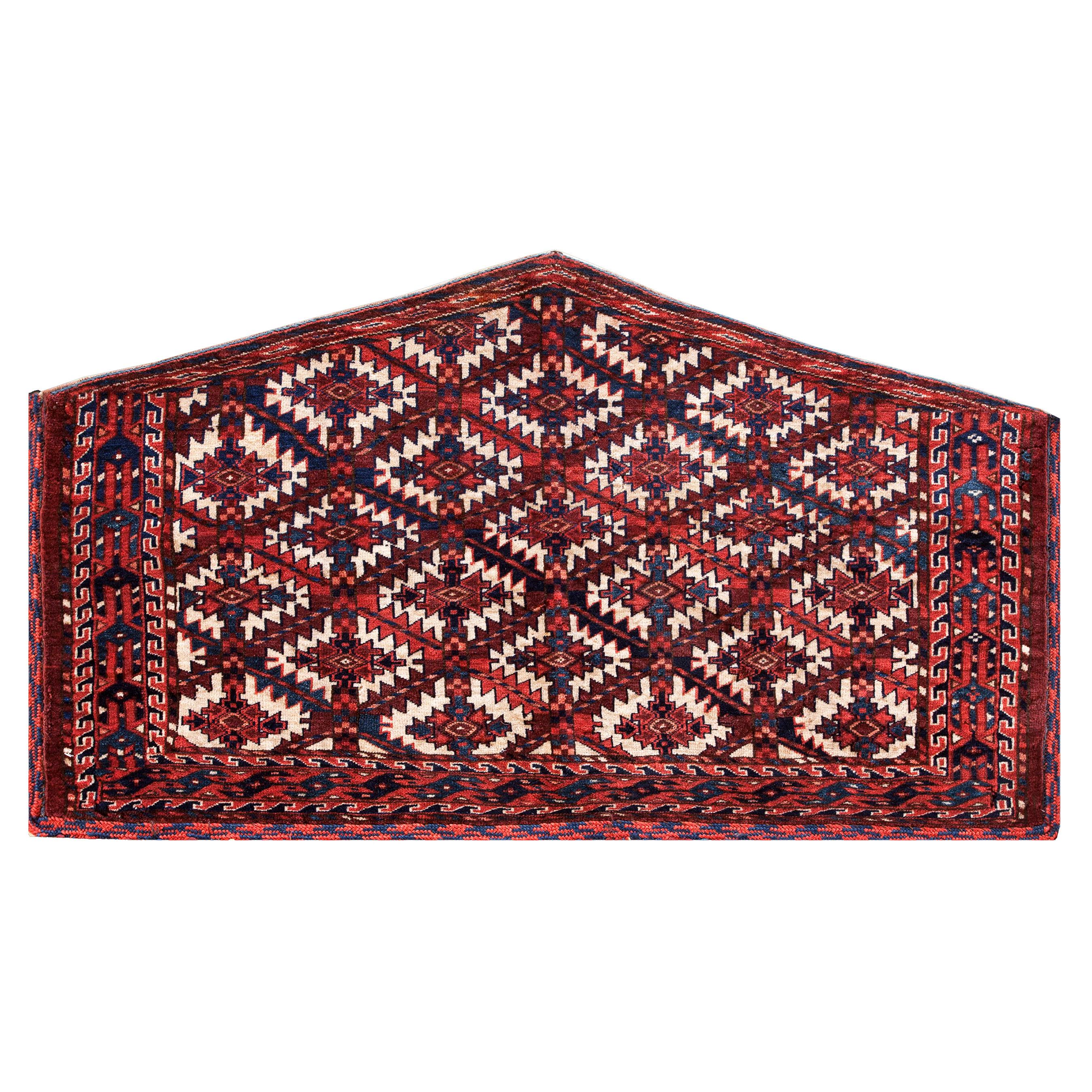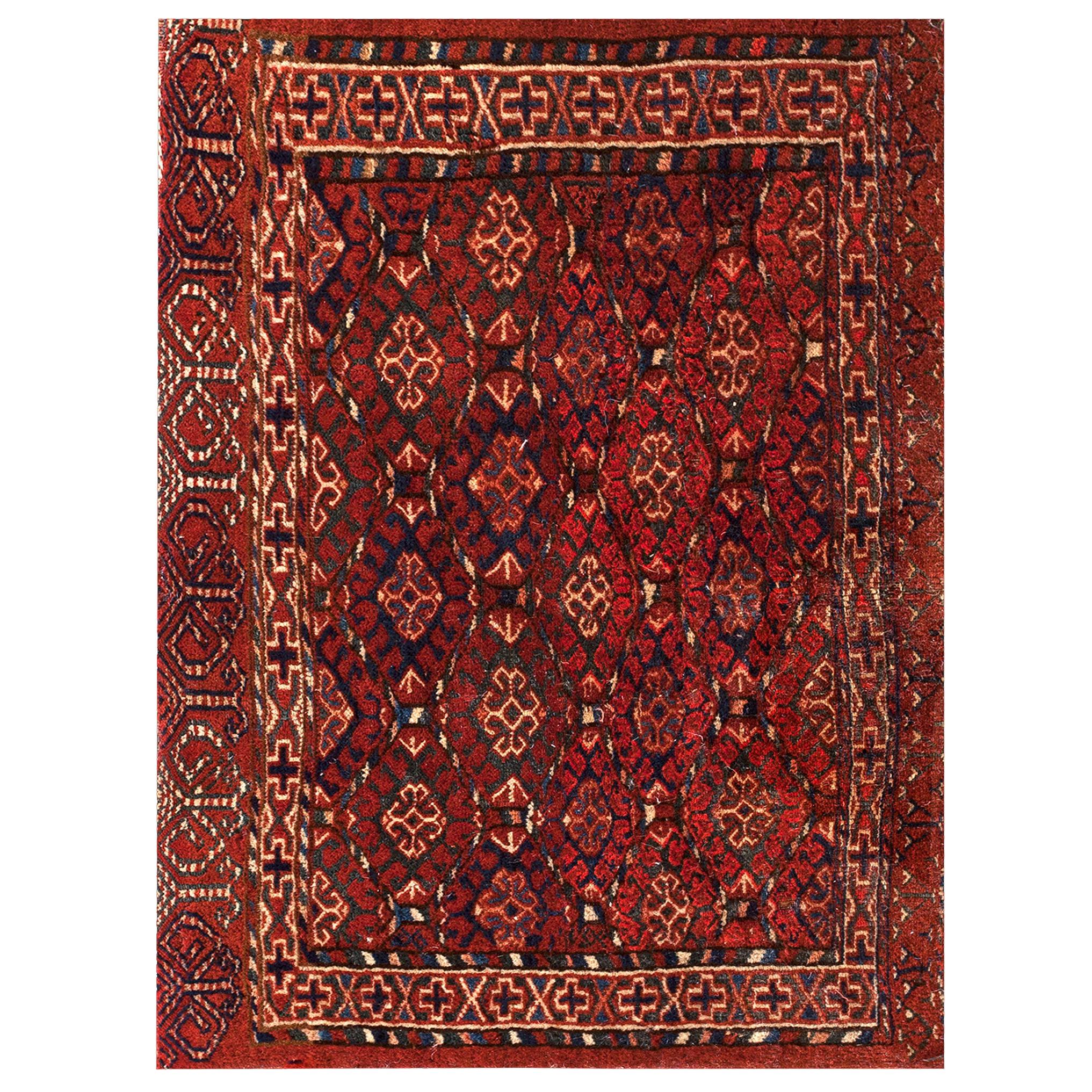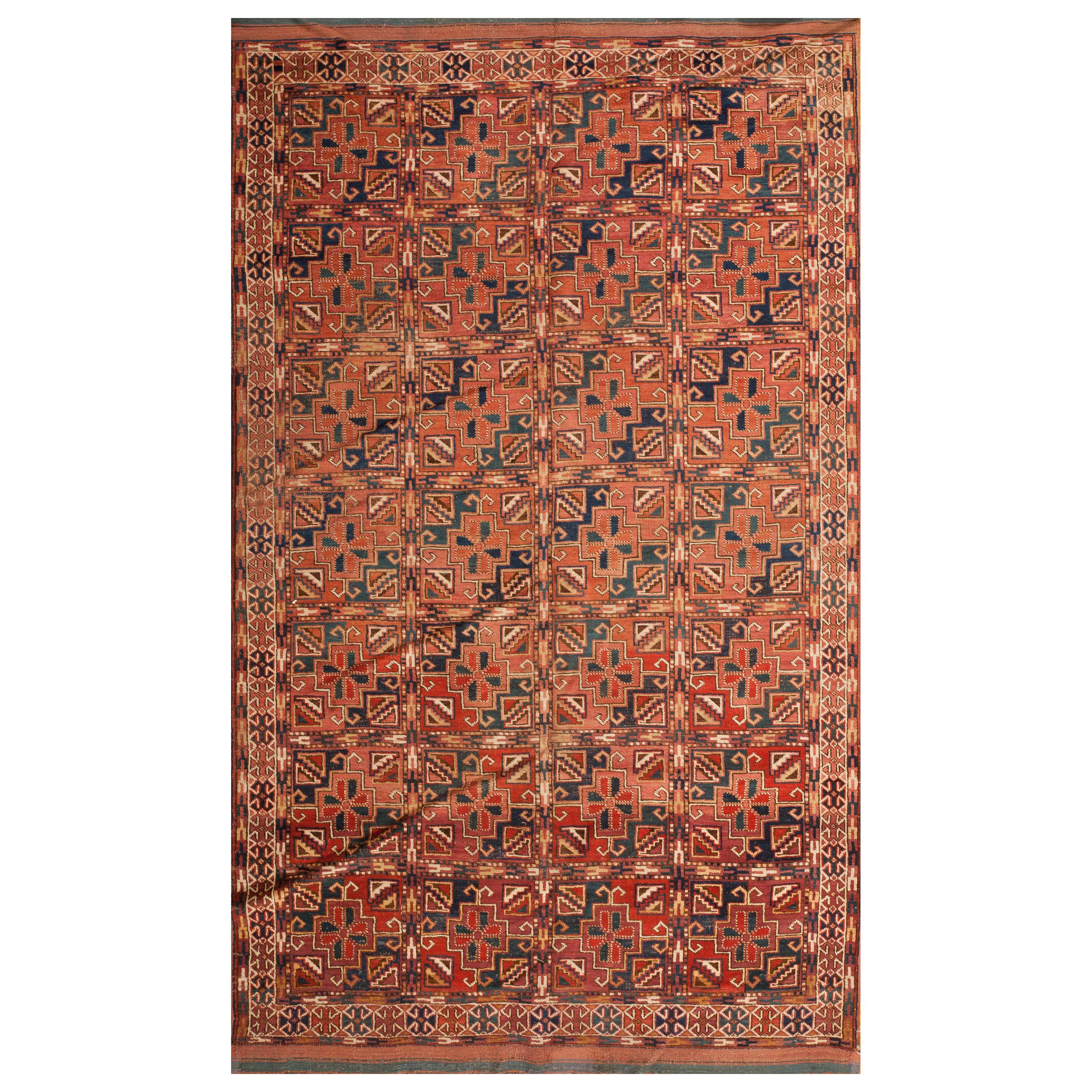Items Similar to Antique Turkmen Salor Part Silk Rug Geometric Design
Want more images or videos?
Request additional images or videos from the seller
1 of 5
Antique Turkmen Salor Part Silk Rug Geometric Design
About the Item
Salor rug, floor covering handmade by the Salor Turkmen of Turkmenistan. Most consistent in design are the main carpets, with a quartered gul (motif) showing a small animal figure in the inner part of each quadrant. The faces of storage bags are more varied, with several types of guls, most of which are shared by the Tekke and Saryk tribes, to whom the Salor seem most closely related. Salor ensis have been identified, and the tribe has produced a group of unusually long pieces in torba (storage-bag) form that seem to be intended as decorative trappings. Patches of pink silk are found in some examples, which also show structural differences setting them apart from other Turkmen rugs.
Turkmen tradition maintains that the Salor are an ancient tribe of high status, although their fortunes have been in decline for the last century and a half.
- Dimensions:Width: 71 in (180.34 cm)Length: 97 in (246.38 cm)
- Style:Other (In the Style Of)
- Materials and Techniques:
- Place of Origin:
- Period:1900-1909
- Date of Manufacture:1900
- Condition:good condition.
- Seller Location:Los Angeles, US
- Reference Number:
About the Seller
5.0
Gold Seller
These expertly vetted sellers are highly rated and consistently exceed customer expectations.
Established in 1920
1stDibs seller since 2023
28 sales on 1stDibs
Typical response time: <1 hour
- ShippingRetrieving quote...Ships From: Los Angeles, US
- Return PolicyA return for this item may be initiated within 3 days of delivery.
More From This SellerView All
- 1920s Antique Floral Design Part Silk Needlework RugLocated in Los Angeles, USNeedlepoint rugs were created using the traditional needlework weaving technique that is used to make everyday items from furniture to carpets and artwork. However, it has a fascinating history both as a hobby and as an industry. When many people think of carpets, they think of pile carpets or flat weave kilims, but needlepoint has also been used to create beautiful carpets. These carpets are durable and an important part of carpet history. Archaeologists and scholars consider the roots of needlepoint to have been around 1500 BC. They consider the first needlepoint to include the fine diagonal stitches that were used to sew tents together by the ancient Egyptians. The art eventually evolved into tapestry weaving. However, a tapestry weaving differs significantly from needlepoint in that it uses a loom and vertical warp. Tapestry weaving is closer to the weaving of kilims and pile rugs than canvas work. However, some still include tapestry weaving in the category of needlepoint because of the fine work that appeared during the late Renaissance. It can have a similar appearance to the untrained eye. Technically, tapestry weaving and needlepoint are not the same, and they do not use the same technique. The first actual needlepoint rugs and needle-points began to appear in the late Renaissance. Needlepoint is worked by creating stitches on a stiff canvas. The canvas is typically made from jute or linen and is quite durable. Pieces from the Renaissance were used to cover footstools, chairs, pillows, bed headboards, and other furnishings. They were also used as table coverings and wall coverings. You could also find them on many small items such as purses, shoes, and various adornments for clothing. During the Renaissance, the craft reached a high level of skill, and the designs became incredibly detailed and realistic. They mimicked many of the subjects and styles of famous paintings of the time. They created florals, still life designs, scenes, and geometric tiled pieces. Some of them mimicked the designs found in Persian Carpets. Needlepoint reached its peak popularity in the 19th century when it was considered a proper occupation for a lady. Needlepoint and embroidery held a similar place in societal status at the time. During this time, the work became finer, with some of the canvas reaching a high level of detail. The level of detail is determined by counting the number of mesh in an inch. During this time petit point by French needlewomen could have a mesh count as high as 45 mesh. This allowed women to create highly intricate designs with incredible levels of detail. It is possible to find many antique pieces of needlepoint besides rugs. Needlepoint rugs were popular in France and Spain, where the technique was adapted to create highly intricate designs that mimicked the designs in architecture and fashion. They were popular because they were durable, and it could be fashioned into a variety of items. The canvases themselves were durable, and the wool that they used was also strong, which means that many of the pieces were able to withstand daily use. We have many artifacts that have survived from this time period. Needlepoint rugs are important collectibles because they are different from the pile rugs and kilims that are typically found on the market. Needlepoint carpets are special because they take many hours to create, especially larger works. Needlepoint pieces of any type became popular throughout Europe during the 19th century. It is still a popular hobby today, but perhaps one of the most interesting stories is that of the Portuguese needlewomen of Arraiolos. The story of these women and their beautiful carpets begins in 1492. Needlepoint was a popular occupation in Spain, which had a large population of Moors and Jews. They were an integral part of Spanish culture. However, in 1492, Queen Isabella of Spain issued a proclamation that gave these ethnic groups the order to pack their bags and board ships headed...Category
Vintage 1920s Renaissance Revival Russian and Scandinavian Rugs
MaterialsWool, Silk
- Antique Bessarabian Geometric DesignLocated in Los Angeles, USAntique Bessarabian Rugs / Kilims in both pile and tapestry weaving technique are some of the more beautiful carpets to have been produced in Europe. Many of the Bessarabian Kilims w...Category
Antique Early 1900s Asian Other Russian and Scandinavian Rugs
MaterialsWool, Cotton
- Antique Geometric Shirvan RugLocated in Los Angeles, USShirvan rugs – The historic Khanate or administrative district of Shirvan produced many highly decorative antique rugs that have a formality and stylistic complexity that is found in...Category
Antique Early 1900s Other Russian and Scandinavian Rugs
MaterialsWool, Cotton
- 19th Century Geometric Design Samarkand RugLocated in Los Angeles, USAntique Samarkand Rugs: The desert oasis of Khotan was an important stop on the Silk Road. The people of Khotan were expert carpet weavers who produced high quality antique rugs and ...Category
Antique 19th Century Other Russian and Scandinavian Rugs
MaterialsWool, Cotton
- Antique Turkish Silk RugLocated in Los Angeles, USTurkish rugs (also referred to as Anatolian rugs) are, arguably, the rugs that started it all. These carpets were among the first wave of Oriental antique carpets to be exported into Europe. The vintage Turkish rugs were prized commodities and artistically influential pieces. The designs of Turkish rugs such as the iconic guls, prayer rugs and small repeating patterns found on these carpets, worked their way into the iconic paintings of the European masters, including Memling, Lotto, Bellini, Hans Holbein and many others. These painters were inspired so much by Turkish rugs and the design motifs they feature that the artists have lent their names to some of these famous Turkish patterns. One of the most famous artists that incorporated rugs from Turkey in his painting was the great and iconic 16th century painter Hans Holbein. The styles of Turkish rugs...Category
Antique Early 1900s Asian Other Russian and Scandinavian Rugs
MaterialsWool, Cotton
- Antique Tabriz Rug Floral DesignLocated in Los Angeles, USAntique Tabriz rugs are distinguished by their excellent weave and by their remarkable adherence to the classical traditions of antique Persian rug design. But they cannot be disting...Category
Antique Early 1900s Asian Other Russian and Scandinavian Rugs
MaterialsWool, Cotton
You May Also Like
- Bukara Turkmen (Russian) Traditional Geometric Design RugLocated in Ferrara, ITBukara Design's Russian Hand-knotted Traditional rug is the perfect statement piece for your home. This beautiful rug is Hand-knotted with quality materials, and it's sure to add a touch of luxury to any room. With its traditional geometric design, this rug is perfect for adding a bit of history and culture to your space. It's important to note that Bukhara carpets...Category
21st Century and Contemporary Russian Other Central Asian Rugs
MaterialsWool
- Bokhara Rug Turkmen Vintage Geometric Design (6' 11" x 10' 3")Located in Ferrara, ITThis is a beautiful Bukhara carpet that was woven in Turkmenistan circa 1920. It has a rich, deep red background with intricate patterns in cream and white. The carpet is made of woo...Category
Early 20th Century Turkmen Other Russian and Scandinavian Rugs
MaterialsWool
- Antique Baluch Turkmen Rug 2' 4" x 4' 2"Located in New York, NYAntique Baluch-Turkmen rug. Size: 2'4" x 4'2".Category
Antique 1870s Russian Russian and Scandinavian Rugs
MaterialsWool
- Antique Baluch Turkmen Rug 1' 6" x 2' 2"Located in New York, NYAntique Baluch Turkmen rug, size: 1'6" x 2'2".Category
Antique 1880s Russian Russian and Scandinavian Rugs
MaterialsWool
- Antique Baluch-Turkmen RugLocated in New York, NYAntique Baluch-Turkmen rug, size: 5'5" x 8'0".Category
Antique 1890s Russian Russian and Scandinavian Rugs
MaterialsWool
- Antique Turkmen Tekke Rug, Tekke Main Carpet, Turkoman RugLocated in Dallas, TX73357, antique Turkmenistan Tekke rug, Tekke main carpet. This antique Tekke rug features seven vertical columns of the Tekke gül with secondary Gurb...Category
Antique Late 19th Century Russian Tribal Russian and Scandinavian Rugs
MaterialsWool

